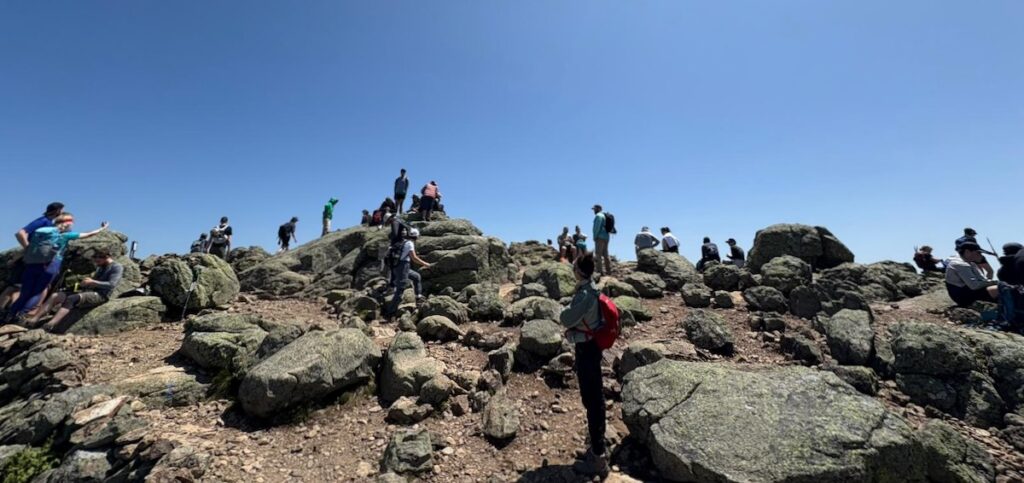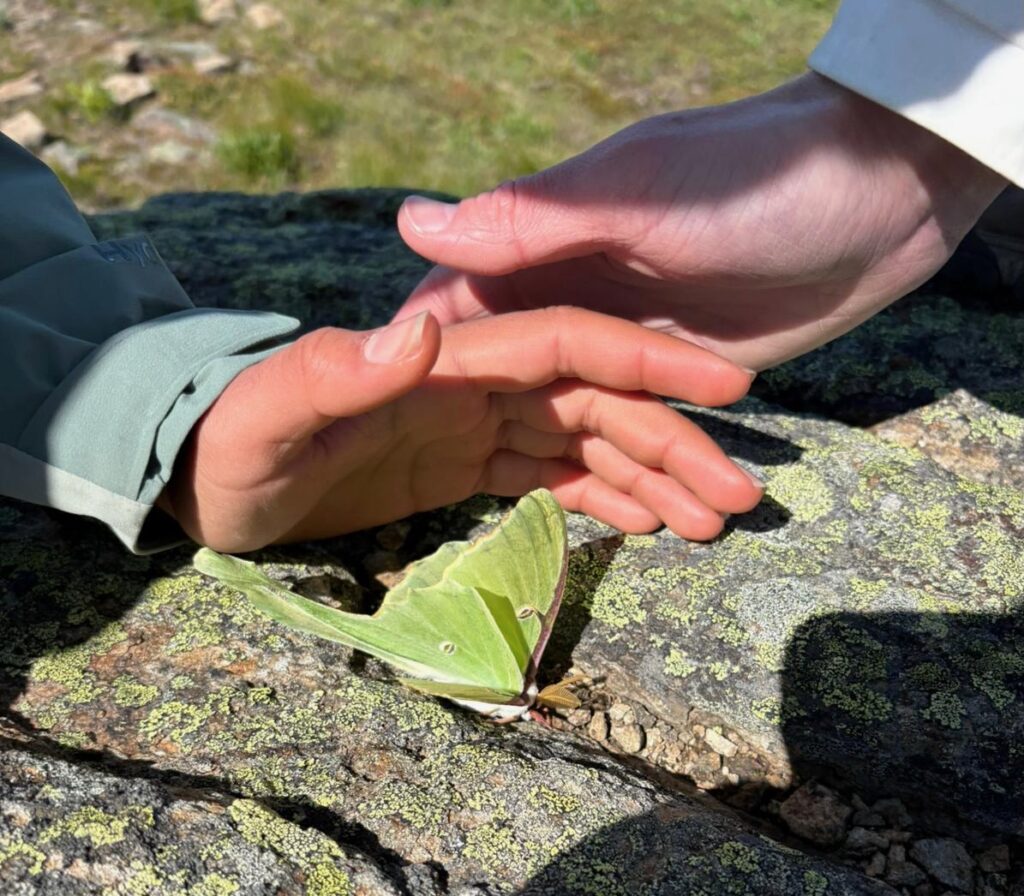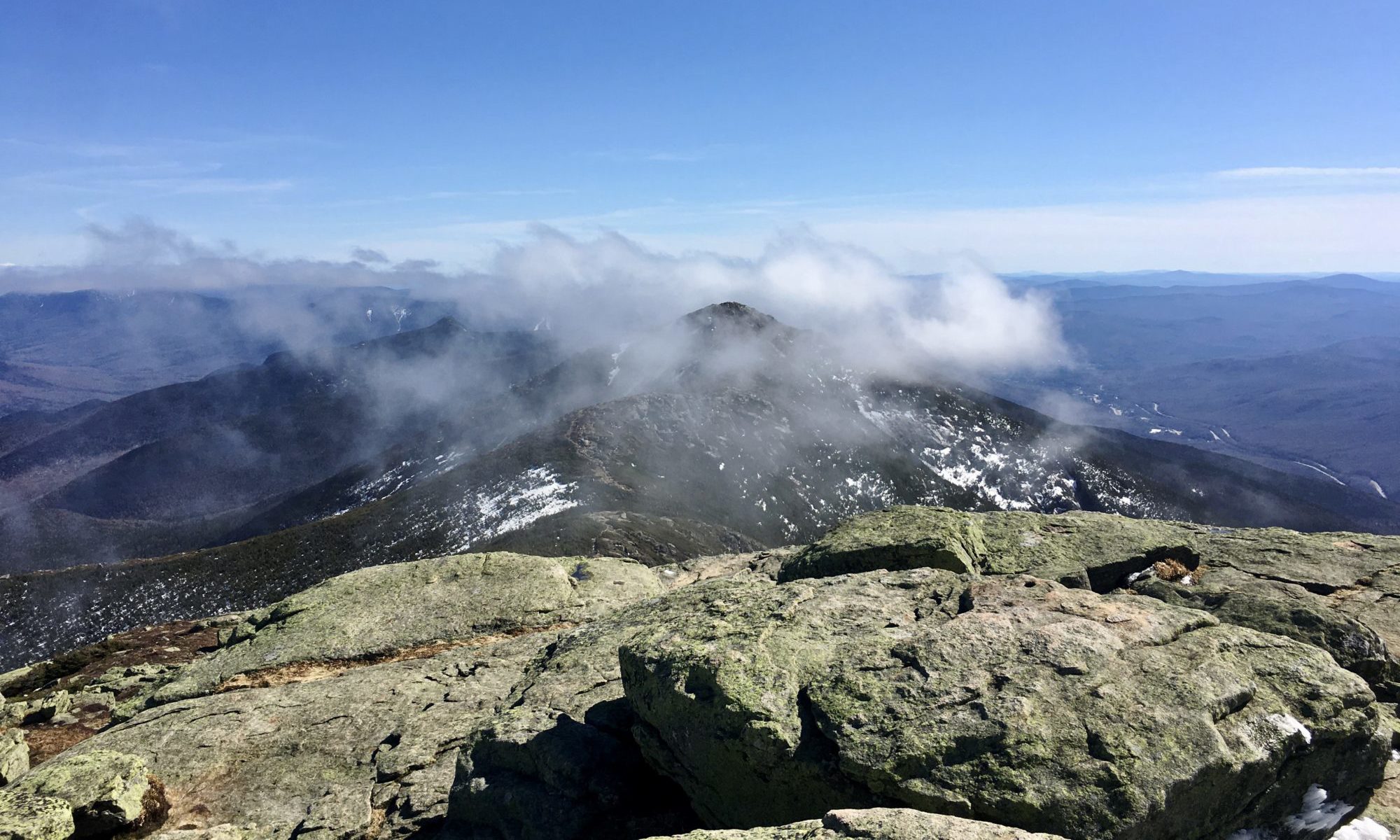Published in the Raven, June 25, 2025

Photo above by Jessica Jagger, Saturday, June 21, 2025
On Saturday, June 21, Pan American Trails Summit Steward Jessica Jagger personally counted 936 visitors traversing Franconia Ridge, making it one of the highest single-day counts. Since she took a lunch break from, the actual number likely surpassed 1,000.
For context, between early July and mid September in 2024, only four days exceeded 900 visitors. Ten years earlier, in 2014, that level of traffic occurred just once. That’s a 300% increase. Similarly, days exceeding 500 hikers more than doubled in the past decade—from 9 in 2014 to 19 in 2024, a 111% increase. These figures point to an unmistakable trend: growing visitation pressure on the Franconia Ridge alpine zone.

Data sources:
2014 trail counts from Reigner, N., Valliere, W., Kiewra, L., Perry, E., & Manning, R. (2017). Monitoring and evaluating indicators of recreational quality on the White Mountain National Forest. 2024 trail counts from the WMNF electronic trail counter on Franconia Ridge.

The graphs above represents just a portion of the season. In 2024, we saw one additional 1,000+ visitor day in October. Between late May and early October 2024, total visitation reached a little over 45,000—up 12.5% from 40,000 in 2023.
As we’ve often noted in The Raven, the total number of visitors in a day or season is less important than visitor passes per hour at specific sections of trail in the alpine zone—that is, the density of people present on the alpine zone at any one time. If we graph this, we see waves or surges of hikers moving past trail counters. This pattern emerges because most visitors begin their hikes or runs within a 3-hour morning window.

When Does Crowd Become Impact?
Last year, White Mountain Environmental Field School student Ally Hollywood monitored off-trail behavior at specific sites. When compared with trail counter data, she noticed that off-trail activity surged once visitor density reached a certain threshold. This suggests a nonlinear relationship: off-trail behavior doesn’t increase steadily with visitor numbers. Instead, it stays relatively low—until a “bifurcation event” occurs, when behavior abruptly shifts. We’ve described these in the past as “chaos moments” on the Ridge.
These are preliminary observations. In 2025, we plan to repeat Ally’s study and refine our methods.

Trails as Complex Systems
Trails aren’t just paths—they behave like dynamic social‑ecological systems.
- Visitors (agents in a system) respond not only to the terrain but also to one another, forming emergent patterns.
- As use intensifies, trails can reach a tipping point—a bifurcation event—where behavior suddenly shifts.
- For example, most hikers stay on-trail until crowding hits a threshold. Then, off-trail behavior surges unexpectedly—what we’ve called a “chaos moment” on Franconia Ridge.
- These dynamics are nonlinear: small increases in crowding can trigger large behavioral changes.
- This mirrors patterns in traffic flow, ecological collapse, and other complex systems.
Why it matters: Trail management must go beyond simple visitor counts. It’s about recognizing and preventing these tipping points before irreversible damage occurs.
Why Some Spots Are Worse Than Others
While off-trail surges are clearly linked to crowding, their intensity varies along different sections of the Ridge. One reason is the trail’s physical characteristics. Ally observed that sections with unclear trail boundaries or many protruding rocks (high rugosity) had significantly more off-trail movement.
Fellow student Ian Skinner identified three trail characteristics that influence off-trail behavior. Adding Ally’s two, we have :
- Trail width – Wider trails (over 4 feet) reduce off-trail movement.
- Step height – High steps (over 8 inches) often prompt users to walk around.
- Trail grade – The ideal grade is 10%. Braided sections often exceed 35%.
- Surface roughness – Trails with uneven, protruding rocks increase detours.
- Trail boundary definition – Clear edges (e.g., scree walls) reduce wandering.
What We Can Do
These observations point to two major direct management interventions:
1. Reducing Crowding
To avoid threshold conditions that lead to bifurcation events, timed entry or staggered access may help. For example, staggering shuttle departures to the Old Bridle Path trailhead could space out hiking groups.
2. Trail Tending and Redesign
- Maintain scree walls and use string fencing strategically
- Widen trails (to ~ 5 feet) to allow passing without stepping off the trail
- Remove protruding rocks where feasible
- Rebuild high steps to be more accessible
- Address trail grade where possible—steep gradients will likely remain due to constraints in the alpine zone, where relocations are unlikely
We hope dialogue between Franconia Notch State Park and the USFS continues to explore timed entry or other strategies to manage crowding on Franconia Ridge.


Combining Direct and Indirect Management
Beyond physical interventions, Summit and Alpine Stewards play a crucial indirect management role through education and interpretation—both in person and via signage. In 2025, the White Mountain Environmental Field School will revamp signage and messaging on the Ridge, incorporating our new mascots, Ravens Franc and Connie, created by 2024 student Declan Buckley.
Finally, we’ll launch photopoint monitoring at select alpine sites, based on work initiated by 2024 student Anya Salters. These photo comparisons over time will help assess which management approaches—direct or indirect—are most effective on Franconia Ridge.
Select References
Wimpey, J. F., & Marion, J. L. (2010). Visitor use and trail width in Acadia National Park.
Leung, Y.-F., & Marion, J. L. (1996). Recreation ecology: The ecological impact of outdoor recreation. USDA Forest Service.
Marion, J. L., & Wimpey, J. (2017). Sustainable trail design and soil loss dynamics.
Marion, J. L. (2024). Recreation Ecology Guidance for Campsite and Trail Monitoring and Visitor Use Management. Virginia Tech.
